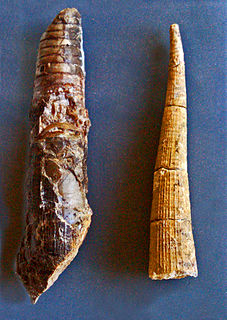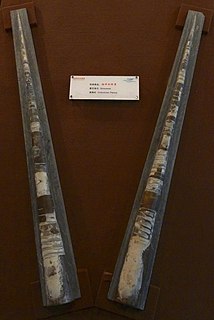Ogmodirus is an extinct genus of plesiosaur found in the Cenomanian-Turonian Greenhorn Limestone of Kansas. It may be member of the Elasmosauridae, a group of marine animals related to Elasmosaurus, but the condition of the fossils discovered to date means the genus is dubious beyond Plesiosauria. The type species, O. martini, was named by Samuel Wendell Williston and Roy L. Moodie in 1913. The original specimen consisted of a pelvic girdle, limb elements, and more than fifty cervical (neck) vertebrae discovered in Cloud County, Kansas. A second species, Ogmodirus ischiadicus, has since been referred to Styxosaurus. Sepkoski (2002) assigned Ogmodirus to the Plesiosauria.
Homaloceras is an extinct nautiloid cephalopod from the Middle Devonian with a strongly curved shell, included in the nautilid family Centroceratidae.

Kionoceras is an extinct nautiloid cephalopod genus included in the orthocerid family Kionoceratidae with scattered worldwide distribution from the Middle Ordovician to the Lower Permian. Kionoceratids are orthocerids with prominent longitudinal ornamentation on their shells, sometimes augmented by secondary transverse ornamentation. Orthocerids are, of course, prehistoric nautiloides with generally straight and elongate shells, mostly with central or subcentral siphuncles.
The Genus Hemichoanella is a small, extinct, orthoconic nautiloid cephalopod from the Lower Ordovician of Western Australia assigned to the orthoceratoid family, Baltoceratidae. Hemichoanella and the Baltoceratidae are part of the subclass of once diverse and numerous shelled cephalopods known as the Nautiloidea.
Gyroceras is an extinct genus of prehistoric nautiloids. The nautiloids are a subclass of shelled cephalopods that were once diverse and numerous but are now represented by only a handful of species.
Faberoceras is an extinct genus of prehistoric nautiloid. The nautiloids are a subclass of shelled cephalopods that were once diverse and numerous but are now represented by only a handful of species.
Endolobus is an extinct genus from the nautiloid order, Nautilida. Nautiloids are a subclass of shelled cephalopods that were once diverse and numerous but are now represented by only a handful of species, including Nautilus. Endolubus is included in the family Koninckioceratidae which is part of the superfamily Taintocerataceae.
Ankyloceras is a genus of Early Devonian cephalopods included in the oncocerid family Karoceratidae. The type species, Ankyloceras nesnayamiense named by Zhuravleva, 1974, comes from Nova Zemlya in Russia. Other species have been found in Japan, Morocco, and Russia.
Cornuella is an extinct genus of prehistoric nautiloid. The only known species of Cornuella is C. parva. The nautiloids are a subclass of shelled cephalopods that were once diverse and numerous but are now represented by only a handful of species. Cornuella shell fossils are known from several locations in Missouri and throughout the UK, including Scotland. Cornuella's shell was slightly curved and strongly ribbed. The fossils of Cornuella from Missouri are Cambrian in age. Cornuella likely lived either at the surface or the bottom of the water column. It was likely a grazer.
Neocycloceras is an extinct genus of nautiloid included in the Pseudorthocerida that lived during the Late Devonian and Mississippian. Neoclycloceras is characterized by a slender, generally circular shell with slightly oblique,sinuous surficial annulations. Its sutures have dorsal and ventral saddles and lateral lobes and become more oblique with age. Saddles point forward, lobes to the rear. Dorsal saddles are broad and low but the ventral ones are high and conspicuous. The siphuncle is located between the center and venter and is nummuloidal, composed of rounded expanded segments, the inside of which contains a continuous laminar lining that is thickest in the middle of the segments and thinnest at the septal necks. Neocycloceras has been found in Pennsylvania in North America and in Morocco in north Africa.
Winnipegoceras is an extinct nautiloid genus from the Ordovician belonging to the Order Discosorida.

Sinoceras is an extinct genus of nautiloids from China included in the family Orthoceratidae that lived from the middle Ordovician until the Devonian. The type species, S. chinense, was originally described as "Orthoceras chinense," but then was promoted by Shimizu and Obata to its own genus, Sinoceras, in 1935.
Wardoceras is an extinct nautiloid genus from the late Early Ordovician of Western Utah, assigned to the orthocerid family, Michelinoceratidae
Westonoceras is an extinct nautiloid genus from the Discosorida that lived during the Middle and Late Ordovician that has been found in North America, Greenland, and Northern Europe. It is the type genus for the Westonoceratidae
Selenoceras is an extinct genus of nautiloids, named by Zhuravleva in 1972, assigned to the Discosorida. Discosorids constitute an order of shelled cephalopods with siphuncle segments that are zoned longitudinally and connecting rings that typically wrap around the septal necks, re-enforcing the septal perforations. Discosorids ranged from the Middle Ordovician possibly to the Upper Devonian.
Stearoceras is an extinct genus of prehistoric nautiloids from the Lower Pennsylvanian - Lower Permian with a fair worldwide distribution.(Kümmel 1964)
Arionoceras is an extinct orthocerid genus from the Middle and Upper Silurian, of Europe that is estimated to have lived from 422.9—418.1 mya, existing for approximately 4.8 million years .
Bogoslovskya is an extinct orthoceroid cephalopod genus that lived in what is now Asia from the Devonian to the Permian.
Geisonocerina is an extinct genus from the carnivorous nautiloid cephalopod order Orthocerida that lived in what would be North America, Europe, and Asia during the Ordovician through Permian from 449—290 mya, existing for approximately 159 million years .
Parasphaerorthoceras is an extinct orthocerid genus, a nautiloid cephalopod, that lived in what would be Europe and north Africa during the Silurian from 422.9—418.1 mya, having existed for approximately 4.8 million years .

